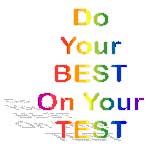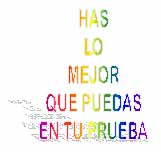|
Thanks to all volunteers that helped out during the End of the Year Picnics on June 13 and 14. Your time and effort are truly appreciated by the students and staff.
Friday, June 3 at 8 a.m. was the Parent Association Bake Sale. At 8:45, the Multi-cultural Dance Festival started.
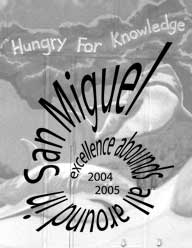 |
excellence abounds all around in San Miguel graces the cover of the 2004-2005 yearbook. Preserve school memories by buying this 48 page edition. The cost will remain at $15. You may look at a mockup copy of this yearbook in the office.
Copies are still available in the school office. |
Grade 2-5 STAR Testing Window May 2 - 20A message from the principal Dear Parents, To help parents learn more about the upcoming testing for grades 2 – 5, Here is some helpful information on Standardized Testing. Information from the Parent Institute®. Questions and Answers about Standardized TestsStandardized tests have been used to measure student achievement and ability for many years. Over the past few years, these tests have become more important than ever. Many states, like California, have defined specifically what students should know and be able to do, grade by grade. They use standardized tests to measure how well students achieve these goals. As college-bound students need a good score on college entrance tests to get into a competitive college, many students need a passing score on a standardized state test to graduate from high school. Some educators say these new test have raised standards for all students. Everyone agrees that tests have a place in education… and that they’re here to stay. Why do students have to take all these tests?Schools have always wanted to know how students are doing. Whether it’s a three-question quiz or a major unit exam, teachers have used tests to measure how well students have learned what they were taught. Standardized tests are designed to give a common measure of how well students are doing. Some of these tests measure how much students have learned about math, reading, or science. Others test a student’s ability to learn in school. California uses its own standardized tests as one way to make sure all students know and are able to do the things that will help them succeed. Tests are one important tool to help you and the school measure how well your child is learning. That’s why it’s important for you as a parent to know all you can about standardized testing. What are standardized tests?Standardized tests are created to see how students from one school or class compare to other students across the city, the state or the country. They give educators a common standard to measure student performance. To measure fairly, these tests need to be given under the same conditions. The amount of time students have to finish the test is strictly controlled. Each is scored in the same way—a student who answers 67 questions correctly gets the same score whether he or she takes the test in California or in Maine. Some tests measure students’ aptitude—their ability to learn. They test a broad range of skills and abilities that can help students do well in school. They might measure verbal ability or mechanical ability, for example. Aptitude tests can help teachers plan instruction that is not too hard and not too easy. Other tests measure achievement—how much students have already learned. They can be used to measure whether students have mastered the information presented in their class.
Why and how are standardized tests used?Testing can help the school: · Evaluate a school program. Testing can help parents: · See how their child’s achievement compares with other students locally and nationwide. Testing can help students: · Better understand their strengths and weaknesses. Test results can tell us a lot. But no important decision should ever be based on the results of a single test. To accurately evaluate a student, your observations as a parent should be combined with those of teachers, other staff, your child and doctors or specialists. What should I ask about standardized testing?As a parent, you have an important role to play in making sure your child does his or her best. Here are some of the questions you should ask about your school’s standardized testing program. 1. When will the tests be given? The testing window is May 2 – 20. The testing window is the time that the schools receive the testing materials to the time they are shipped out to be scored. Students will usually be tested only in the mornings. 2. What are the names of the tests? The California State STAR – Standardized Testing and Reporting – includes the California Standards Tests (CSTs) multiple choice tests for all students in grades 2 through 11 and writing tests for students in grades 4 and 7; and the California Achievement Tests, Sixth Edition Survey (CAT/6 Survey) multiple choice tests for all students in grades 3 and 7. Other components include the Spanish Assessment of Basic Education, Second Edition (SABE/2) multiple choice tests for Spanish-speaking English learners in grades 2 through 11; and the California Alternate Performance Assessment (CAPA) assessment for grades 2 through 11 with significant cognitive disabilities who are unable to take CSTs. 3. How and when will I get the results? Results for testing will be mailed to parents and/or guardians directly from the School District Office as soon as they are received from the testing company; usually in the early part of summer vacation. 4. What can I do at home to prepare my child? Standardized testing will test your student on what he/she has already learned. The best way to prepare your child is: In the months preceding the test: · Find out when the tests are to be given. Write the date and time on your calendar. Avoid scheduling appointments or trips during these times. · Ask the teacher what you can do at home. Before some state tests, the teacher might ask you to review math facts, for example. · Read, read, read. The easiest and best way to prepare your child for doing well on tests is to encourage him or her to read. Right before the test: · Make sure your child gets a good night’s sleep. · Make sure he or she eats breakfast. · Have your child dress in layers—kids do better on tests if they don’t have to think about how hot or cold they are. · Don’t be too anxious, but make sure your child knows that it’s important to do his or her best. Review test-taking strategy with your child on test day: · Remind your child to follow directions carefully and ask questions if something is not clear. · If you child doesn’t know the answer to a question, he or she should skip it and move on. He or she can always come back later. · Remind your child to check his or her answers carefully. He or she should make sure the answer to questions 7 is marked on the answer sheet next to number 7. · Remember, children who love learning are more likely to do better on tests. Instill a positive attitude about school!! |
PRUEBA STAR GRADOS 2-5 DEL 2 AL 20 DE MAYOMensaje de la Directora Estimados Padres, Para ayudar a los padres a saber más sobre las pruebas ya por llegarse para los grados 2-5, héa aquí alguna información que les ayudará a ententer sobre las Pruebas estandarizadas. Información del Instituto de Padres.
Preguntas y Respuestas Sobre Pruebas EstandarizadasLas pruebas estandarizadas han sido usadas para evaluar el aprovechamiento y la habilidad por muchos años. Hace pocos años, dichas pruebas se han convertido más importantes que nunca. Muchos estados, como California, han definido especificamente lo que los estudiantes deben saber y sepan hacer, grado por grado. Ellos usan la prueba estandarizada para evaluar que tan bién los estudiantes logran estas metas. Como el límite-colegial los estudiantes necesitan sacar buenos grados en la prueba de admición para poder entrar a un colegio competitivo, muchos estudiantes necesitan un buen grado en la prueba estandarizada estatal para graduar de secundaria (high school). Algunos educadores dicen que estas nuevas pruebas han elevado los estándarez para todos los estudiantes. Todo mundo está de acuerdo en que las pruebas tienen un lugar en la educación…y que estan aquí para quedarse. Porqué los estudiantes deben de tomar estas pruebas?Las escuelas siempre han querido saber como van los estudiantes. Ya sea una prueba de tres preguntas o un examen mayor, los maestros han usado las pruebas para saber que tan bién han aprendido los estudiantes lo que se les ha enseñado. Las pruebas estandarizadas están diseñadas para evaluar comunmente como van los estudiantes. Algunas de estas pruebas indican cuanto han aprendido en matemáticas, lectura, o ciencias. Otras pruebas mustran la habilidad del estudiante para aprender en la escuela. California usa sus própias pruebas estandarizadas como una forma para asegurarse de que todos los estudiantes sepan y puedan hacer cosas que les ayuden a triunfar. Las pruebas son una herramienta importante para ayudarles a saber ustedes y a la escuela que tan bién esta aprendiendo su hijo/a. Por eso es tan importante para usted como padre saber todo lo que pueda sobre las pruebas estandarizada. Qué son las pruebas estandarizadas?Las pruebas estandarizadas son creadas para ver como unos estudiantes de una escuela o clase van compadados con otros al otro lado de la ciudad, el estado o el país. Les proveé a los educadores una forma estándar común de evaluar el desarrollo del estudiante. Para evaluar justamente, estas pruebas deben darse bajo las mismas condiciones. La cantidad de tiempo en la que los estudiantes deben terminar la prueba es estrictamente controlada. Cada una es corregida en la misma forma-un estudiante que conteste 67 preguntas correctamente saca la misma calificación ya sea que tome la prueba en California o en Maine. Algunas pruebas evaluan la aptitud de los estudiantes-su habilidad para aprender. Evaluan un amplio campo de habilidades que pueden ayudar a los estudiantes a ir mejor en la escuela. Puede ser que evaluen la habilidad verval o mecanica, por ejemplo. Una prueba de aptitud puede ayudar al maestro a planear su instrucción para que no sea tan difícil o tan fácil. Otras pruebas evaluan el aprovechamiento-cuanto hanyan aprendido los estudiantes. Pueden ser usadas para evaluar si los estudiantes han aprendido la información presentada en su clase. Porqué y para que se usan las pruebas estandarizadas?Las pruebas pueden ayudarle a la escuela a: · Evaluar el programa de la escuela. Las pruebas pueden ayudar a los padres a: · Ver como el aprovechamiento de su hijo/a comparado con otros estudiantes localmente o nacionalmente. Las pruebas pueden ayudar a los estudiantes a: · Entender mejor sus debilidades y potenciales. Los resultados de las pruebas nos pueden indicar mucho. Pero ninguna decisión importante debe basarse en el resultado de una sola prueba. Para verdaderamente evaluar a un estudiante, su observación como padre debe combinarse con la del maestro, otro empleado de la escuela, su hijo/a y doctores o especialistas. Qué debo preguntar sobre las pruebas estandarizada?Como padre, tiene un papel muy importante que desempeñar en asegurarse que su hijo/a haga lo mejor que el o ella pueda. Hea aquí una preguntas que algunas de las preguntas que debe hacerle a la escuela acerca del programa de pruebas estandarizadas. 1. Cuándo se darán las pruebas? El tiempo de pruebas es entre el 2 y 20 de Mayo. Es este el tiempo cuando las escuelas reciben los materiales para las pruebas hasta la fecha en que se regresan para ser calificadas. Usualmente los estudiantes solo toman las pruebas durante las mañanas. 2. Cuales son los nombres de las pruebas? El California State Star – Pruebas Estandarizadas y Reportes – incluyendo La Prueba Estandrizada de California (CSTs) pruebas de selección multiple para los estudiantes del 2 grado hasta el 11 y pruebas de escritura para los estudiantes del 4 al 7; y las pruebas de Aprovechamiento de California, Sixth Edition Survey (CAT/6 Survey) prueba de selección multiple para los grados de 3 a 7. Otros componentes incluyen La Evaluación en Español de Educación Básica, Segunda Edición (SABE/2) prueba de selección multiple para los estudiantes de habla Hispana que estan aprendiendo Inglés en los grados del 2 hasta el 11, y el California Alternate Performance Assessment (CAPA) evaluación para los grados del 2 hasta el 11 con cognitivos significativos de minusvalía quienes no pueden tomar el CSTs. 3. Cómo y cuando recibiré los resultados? Los resultados de las pruebas serán enviados por correo a los padres o tutores directamente por la Oficina del Distrito Escolar tan luego los reciban de la compañía de pruebas; usualmente al inicio de las vacaciones de verano. 4. Qué puedo hacer para preparar a mi hijo/a? La prueba estandarizada evaluará al estudiante en lo que el/ella ya ha aprendido. La mejor forma de preparar a su hijo/a es: En los meses presedentes a la prueba: · Infórmese cuando se van a dar las pruebas. Anote las fechas y el horario en su calendario. Procure no hacer citas o viajes durante este tiempo. · Preguntele a la maestra que es lo puede hacer en casa. Antes de algunas pruebas estatales, la maestra/o puede pedirle que repase las tablas matemáticas, por ejemplo. · Leer leer, leer. La más fácil y mejor forma de preparar a su hijo/a para que salga bién en las pruebas es la de impulsarlo a leer.
Antes de la prueba: · Asegurese de que su hijo/a duerma bién por la noche. · Asegurese de tome el desayuno. · Haga que se vista en capas-a los estudiantes les va mejor si no tienen que pensar si hace calor o frío. · No este muy ancioso, pero asegurese de que su hijo/a sepa que tan importante es que el trate de hacer lo mejor que pueda.
Repase estratégias para tomar pruebas con su hijo el día de la prueba: · Recuerdele a su hijo/a seguir las instrucciones cuidadosamente y hacer preguntas si no entiende algo. · Si su hijo no sabe la respuesta en alguna pregunta, el o ella debe pasarsela y proseguir. El o ella puede regresarse despues. · Recuerdele que debe revisar cuidadosamente sus respuestas. El o ella debe asegurarse de que la pregunta 7 debe contestarse en el número en su hoja de respuestas. · Recuerde, a los niños que les gusta aprender usualmente les va mejor en las pruebas. Infunda una actitud positiva sobre el estudio!!!! |
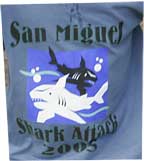 Total monies collected to date is $5450 after expenses. Total monies collected to date is $5450 after expenses.
T-shirts are still available for a $25 or greater contribution. Official Walk-a-thon Winners are: 1st- DVD Player and Shark Tale Movie 2nd- Nintendo DS and Carrying Case 3rd- Digital Camera and Carrying Case We would like to recognize the following students for bringing in over $100 in pledges: Caleb Kenji Kondo (Ms. Sibley) - sorry about the omission |
|
| In the last San Miguel Parent Association General Meeting, Mrs. Bravman, Mrs. Kramer, and Mrs. Hernandez discussed S.T.A.R. Testing and how parents can help improve their children's test performance. Meeting was on Tuesday, April 5 at 2:20 p.m. in the Multi. |
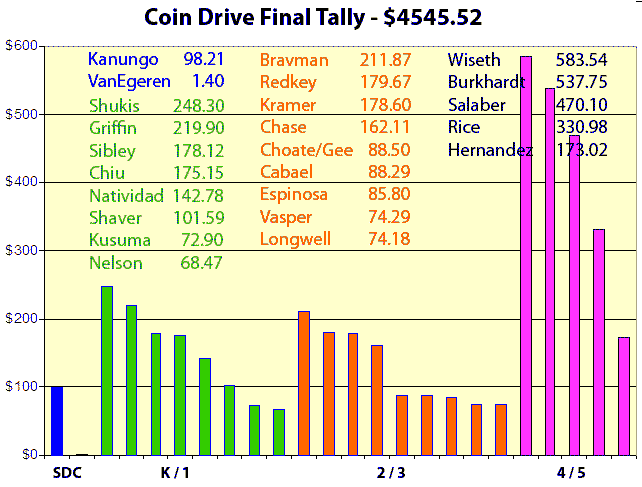
The Coin Drive concluded Friday, February 18. Pizza Parties (along with a movie) were held for the winners in the SDC, K-1, 2-3, 4-5 grade categories. And the winners areMs. Kanungo, Ms. Shukis, Mrs. Bravman, Mrs. Wiseth.This will fund the End-of-the-Year picnics. Thanks to all for a spirited competition and to all who have contributed to San Miguel. |
The Parent Association meeting was Tuesday, February 1 at 6:30 pm in the Multi. Greg Othon, Neighborhood Resource Officer, along with Officers Carl and Scott spoke on the subject of Gangs and parenting. |
|||||||||||||||||||||||||||||||||||||||||||||||||||||||||||||||||||||||||
|
The first Box Tops contest ended 2:50 pm Friday, January 14. Mrs. Nelson’s class collected 518 Box Tops among her 17 students. That is almost 30½ Box Tops per student! Her class wins an ice cream party. There have been 3223 Box Tops collected as of this date. Thanks to everyone for a job well done. Keep collecting for the second contest ending May 26. |
||||||||||||||||||||||||||||||||||||||||||||||||||||||||||||||||||||||||
 Reading Road to Success Reading Road to Success
Students will be on the Accelerated Reader Raceway navigating their way to the Bronze, Silver, Gold medals and the Principal’s Award. Drop by the office to take a look at their progress. |
Solar Viewing for the 3rd through 5 graders was Friday, February 4. Dotty Calabrese used the SOHO website and the Stanford Solar Center website during computer lab. Michael Swartz (from two years ago) has a 4” refractor with a hydrogen alpha filter to look and prominences and another to look at the entire solar disk. I set up my 11” telescope to look at one of two sunspots. | ||||||||||||||||||||||||||||||||||||||||||||||||||||||||||||||||||||||||
| 5% of your purchases at Office Depot go back to San Miguel (ID# 70015613) each quarter with the last one ending 12/31/04. Total purchases must be greater than $200 each quarter for San Miguel to receive a check. | |
| The Holiday Gift Shop was after school Thursday, December 9 from 2 - 4 pm and Friday, December 10 from 12:15 - 4 pm. Drop by and purchase low cost and unique gifts for family and friends. | Author and illustrator, Elisa Kleven visited on Friday, November 5. She held two assemblies, read to kindergartners, and hosted a Writers' Workshop for select 4th and 5th grade students, and signed autographs in the LRC during lunch and after school. |
|
Back to School Night was Tuesday, September 21. There was a presentation on PeaceBuilders at 6 pm followed by Bond Measures L and P. |
The 4th annual San Miguel Star Party was from 7 to 8:30 pm on Wednesday, November 17 on the blacktop for 3rd through 5th graders and their families. A 5 day old crescent moon was visible, but unfortunately no big planets. The Ring Nebula (M57) was viewed through my 11” telescope, Uranus in an 8” reflector, the moon, Andromeda galaxy (M31), and a binary star. Thanks to Dotty Calabrese for setting this up and members of the San Jose Astronomical Association. |
| Bake Sale was Tuesday, September 21 from 5:45 - 8 pm during Back to School Night (6:00-7:30 pm). Parents, staff, and friends brought tempting treats. There was a Teachers’ Table for displaying their goodies. Proceeds go to the Learning Resource Center (library) for Accelerated Reader quizzes, books, and supplies.
We raised $281.95 for the LRC. |
The Catalog Sale got underway Thursday, September 2 and ended September 16. There were Target gift cards for First Place $100, Second Place $50, Third Place $25 and 7 $15 gift cards given as incentives to the top student sellers. Those who sold 5 or more items by Tuesday September 7, drew a prize from Sammy Shark's Treasure Chest. For every 10 items sold, a ticket was entered for the raffle drawing to the Treasure Chest.
Delivery of goods was Friday, October 15 to your child's classroom. The sale netted $11,685 for San Miguel. The following teachers had 80% classroom participation and got gift bags with $50 in merchandise from Signature Fundraising: Mrs. Bravman Ms. Burkhardt Ms. Kanungo Congratulations to Ms. Burkhardt’s class for selling 210 items worth $1989.50. She received a $50 gift card to her favorite restaurant. For every 10 items sold, a student received a ticket toward a drawing from Sammy’s Treasure Chest. The five winners were David Angulo, Joshua Roylance, Caleb Kondo, Alejandra Canas, and Daniel Gutierrez. Thanks to all teachers for encouraging students to participate and thanks to all for selling so many items from the 2004 catalog. |
| Parent Meeting was Thursday, August 26 at 8 am in the Multi. Mrs. Brenda Guy talked about implementing the PeaceBuilders program |
Election Recap
| Measure P on the November 2 ballot will provide a $120 million bond measure for Sunnyvale School District. It will add $24 per $100,000 of assessed home value to your property taxes each year.
The actual text from the voters’ pamphlet reads - To maintain a safe learning environment at Sunnyvale’s elementary and middle schools by replacing 40 year old gas, water and sewer lines; improving and expanding school libraries; installing energy efficient heating and cooling systems; replacing portables with permanent classrooms; expanding school facilities to relieve overcrowding; and making essential school improvements shall Sunnyvale School District issue $120 million in bonds at legal rates, with citizen oversight, no money for administrators and all funds staying locally? Yes 73.0% (55% required to pass) |
Measure L on the November 2 ballot will levy an additional property tax for the Fremont Union High School District.
The actual text from the voters’ pamphlet reads - In order to maintain high quality education at our local high schools – Cupertino, Fremont, Homestead, Lynbrook and Monta Vista High Schools – by preserving core academic classes,maintaining qualified and experienced teachers and school employees, and continuing programs that help our students qualify for college, shall the Fremont Union High School District levy $98 per parcel annually for 6 years to benefit local schools with an exemption for seniors, no money for administrators and all money staying in our community? Yes 67.0% (66.6% required to pass) |
